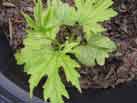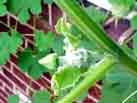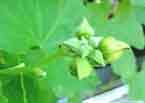 |
 |
 |
 |
 |
Sponge Luffa
Another vine type plant. Luffa is classified as a warm-season crop with a growing season from 100 to 180 days. Outdoor planting should occur when danger of frost has passed, and soil and air temperatures have warmed. Gourd seeds may rot before germinating if planted in cold, wet soils.
Luffa seeds require special handling to ensure uniform germination. Seeds should be scarified (make the seed coat more permeable to air and water) by roughening the side of the seeds with an emery board or sandpaper and then soaking in room temperature water for 24 hours prior to seeding into pots or the garden.
Plant seeds or transplants singly 2 feet apart in the row, with rows 5 feet apart; or in hills (thinned to 2 plants), 4 to 5 feet apart with rows 7 feet apart. Gourds are vigorous growers and will readily adapt to a trellis, fence, or arbor for support. For luffa plants, a very sturdy support is essential to keep all developing fruit off the ground. Fruit will form areas of discoloration if allowed to come in contact with the ground.
Luffa gourds have specific harvesting and processing techniques to produce high quality sponges. Harvest when the outer shell is dry, the gourd is light in weight and the seeds rattle inside. Remove the stem end of the gourd and shake out the seeds from the center cavity. Soak the luffa gourds in warm water until the outer skin softens to the point where it can be easily removed. Then soak the fibrous sponge in a solution of 1 part bleach to 9 parts water to obtain the desirable creamy-white appearance. Rinse in clear water and allow to dry before using.